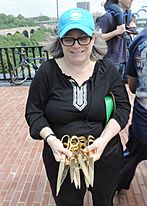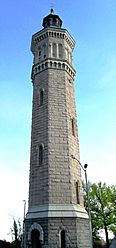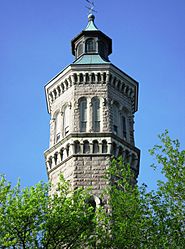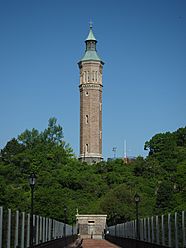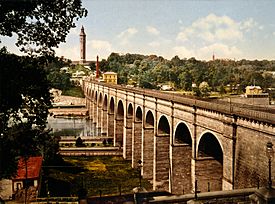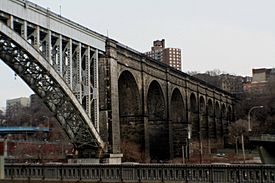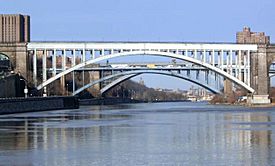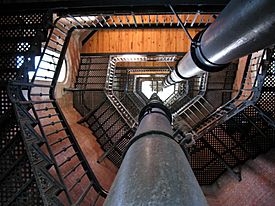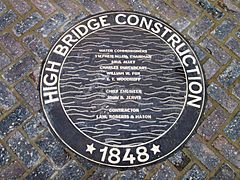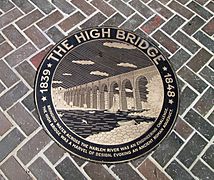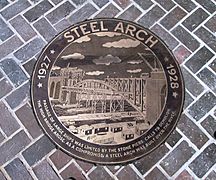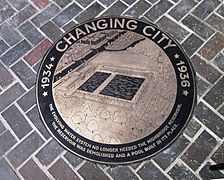High Bridge (New York City) facts for kids
Quick facts for kids High Bridge |
|
|---|---|
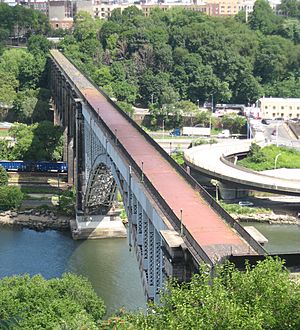
View of the closed bridge from Highbridge Park in 2008
|
|
| Coordinates | 40°50′32″N 73°55′49″W / 40.842308°N 73.930277°W |
| Carries | Pedestrians and bicycles |
| Crosses | Harlem River |
| Locale | Manhattan and the Bronx, New York City |
| Owner | City of New York |
| Maintained by | NYC Parks |
| Preceded by | Alexander Hamilton Bridge |
| Followed by | Macombs Dam Bridge |
| Characteristics | |
| Design | Arch bridge |
| Total length | 1,450 ft (440 m) |
| Clearance below | 140 ft (43 m) |
| History | |
| Opened | 1848 (original aqueduct) |
| Rebuilt | 1927 (partly rebuilt) 2015 (reopened as walkway) |
| Closed | 1970s–2015 |
The High Bridge is the oldest bridge in New York City. It first opened in 1848. It was part of the Croton Aqueduct, which brought water to the city. After being closed for over 45 years, it reopened in 2015 for people to walk and bike across.
This bridge is a steel arch bridge. It stands 140 ft (43 m) above the Harlem River. The High Bridge connects two parts of New York City: the Bronx and Manhattan. On the Bronx side, it's near West 170th Street in the Highbridge area. On the Manhattan side, it's in Highbridge Park, close to West 174th Street.
When it was first built in 1848, the High Bridge had 16 stone arches. In 1928, five of these arches over the Harlem River were replaced with a single steel arch that is 450-foot (140 m) long. The bridge was closed from the 1970s until its repair work began in 2009. It finally reopened for walkers and cyclists on June 9, 2015.
The New York City Department of Parks and Recreation takes care of and maintains the High Bridge.
Contents
Building the High Bridge
How the Bridge Was Built
The High Bridge was first designed as a stone arch bridge. It looked a lot like an old Roman aqueduct. Building the bridge started in 1837 and finished in 1848. It was a key part of the Croton Aqueduct system. This system brought fresh water from the Croton River to New York City, which was growing very fast.
The bridge is 140 ft (43 m) tall above the Harlem River, which is about 620-foot-wide (190 m). The whole bridge is 1,450 ft (440 m) long. Major David Bates Douglass first designed the bridge. Later, the aqueduct's engineering team, led by John B. Jervis, took over the design. James Renwick, Jr., who also designed the famous Saint Patrick's Cathedral, helped with the design.
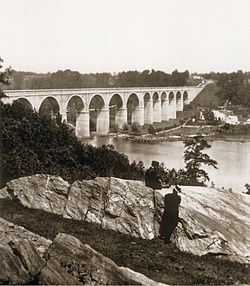
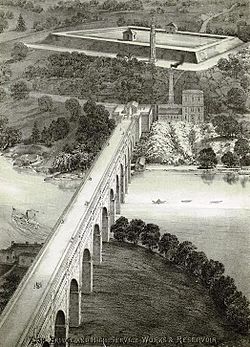
The Croton Aqueduct needed to cross the Harlem River. Engineers thought about building a tunnel under the river. But tunneling was new back then, so they decided against it. This left building a bridge. There was a debate about whether to build a low bridge or a high bridge. A low bridge would have been cheaper and faster. However, the New York State Legislature decided on a high bridge. This was because a low bridge would block boats trying to travel along the Harlem River to the Hudson River.
How the Bridge Was Used
In 1864, a walkway was added to the High Bridge. The New York City Department of Parks and Recreation (NYC Parks) said it was like a "High Line" for its time. But the bridge was never used for cars or other vehicles.
In 1928, changes were made to help boats pass more easily on the Harlem River. The five stone arches over the river were taken down. They were replaced with a single steel arch about 450 feet (140 m) long. Most of the original stone arches from 1848 are still there on the Bronx side. Only one remains on the Manhattan side.
The bridge stopped carrying water to Manhattan on December 15, 1949.
By the 1950s, the bridge started having problems with upkeep and damage. In 1955, the bridge was given to the Parks Department. There were times in 1957 and 1958 when people threw things from the bridge. This caused injuries to passengers on tour boats passing below. These safety concerns led to the bridge being closed. NYC Parks says it closed in 1970.
The Aqueduct System
The High Bridge was a vital part of New York City's first reliable water system. In the 1830s, the city faced serious problems. A disease called cholera spread in 1832. Then, a huge fire in 1835 showed that the city's water supply (from wells and cisterns) was not good enough.
Many ideas were looked at to fix the water problem. Finally, the Croton River in northern Westchester County was chosen. It had enough clean water for the city. The system to bring this water to the city started in 1837 and was finished in 1848.
The Old Croton Aqueduct was the first of its kind in the United States. This amazing system used gravity to move water. The water dropped about 13 inches (330 mm) for every mile. It traveled 41 miles (66 km) into New York City. The water flowed through an enclosed stone structure, crossing hills, valleys, and rivers.
Later, the bridge stopped carrying water in 1917. This was because a newer aqueduct, the New Croton Aqueduct, was built. In the 1920s, the bridge's stone arches were seen as a danger to ships. The city thought about tearing down the whole bridge. But local groups wanted to save this historic bridge. So, in 1927, five of the original arches over the river were replaced with a steel span. The other arches were kept.
Restoring the Bridge
In November 2006, the Department of Parks and Recreation announced plans to reopen the bridge. They hoped it would be ready for walkers by 2009. But this date was pushed back several times. A $20 million project was planned to fix the bridge. This included making the arch stronger, improving the stairs, and adding cameras.
In 2009, planning began for the High Bridge's restoration. This was funded by PlaNYC. The High Bridge Coalition worked hard to raise money and awareness. They wanted the bridge to reopen for people walking and biking. This would connect the Highbridge Parks in Manhattan and the Bronx. These parks cover over 120 acres (0.49 km2) of land. The bridge would also become part of New York's greenway system.
On January 11, 2013, the mayor's office said the bridge would reopen by 2014. But in August 2014, the opening was delayed to spring 2015. In May 2015, the Parks Department announced a July opening and a festival. The ribbon was cut for the restored bridge on June 9, 2015, around 11:30 a.m. The bridge opened to everyone at noon that day.
High Bridge Water Tower
The High Bridge Water Tower is located in Highbridge Park. It's on the Manhattan side of the High Bridge, between West 173rd and 174th Streets. This tower was built between 1866 and 1872. Its purpose was to help meet the city's growing need for water.
The tower is 200-foot (61 m) tall and has eight sides. It was designed by John B. Jervis, who also oversaw the building of the High Bridge Aqueduct. Water was pumped up 100 feet (30 m) to a 7-acre (2.8 ha) reservoir next to the tower. This reservoir is now a play center and public pool. From the reservoir, water was lifted to the tower's 47,000 US gallons (180 m3) tank. This "high service" helped improve water pressure for the city, especially with more people using flush toilets.
The High Bridge water system reached its full capacity by 1875. When the newer Croton Aqueduct opened, the High Bridge system was used less. During World War I, it was completely shut down because people worried about sabotage. In 1949, the tower stopped being used for water. In 1958, a set of bells called a carillon was put in the tower.
In 1984, the top part of the tower was damaged by a fire. It was rebuilt, and the tower's stone outside was cleaned and fixed in 1989–1990. The tower's design mixes Romanesque Revival and neo-Grec styles. Its rough granite gives it a strong, castle-like look.
The inside of the tower has a wide, detailed iron spiral staircase. It has six large landings and pairs of windows. The public has never been able to go inside the tower.
The High Bridge Water Tower was named a New York City landmark by the New York City Landmarks Preservation Commission in 1967.
Gallery
-
The change from the steel arch over the Harlem River to the stone arches over the Major Deegan Expressway
-
Three Harlem River bridges: High Bridge closest; Alexander Hamilton Bridge; and Washington Bridge, farthest. Washington Heights on left; the Bronx on right
- Walkway plaques
See also
 In Spanish: High Bridge (Nueva York) para niños
In Spanish: High Bridge (Nueva York) para niños





